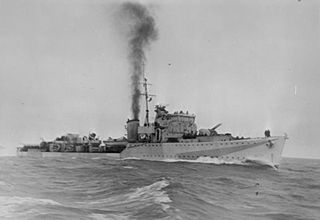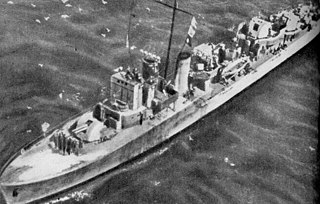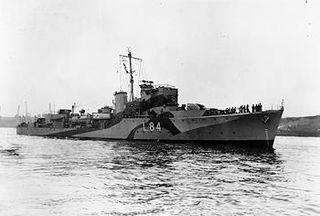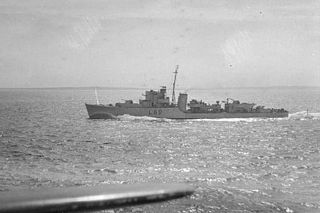
HMS Quorn was a Hunt-class destroyer of the Royal Navy, built in 1940 and sunk off the Normandy coast on 3 August 1944. The class were named after British fox and stag hunts, in this case, the Quorn Hunt, which was originally based in Quorn Leicestershire.

The Second Battle of Sirte was a naval engagement in the Mediterranean Sea, north of the Gulf of Sidra and south-east of Malta, during the Second World War. The escorting warships of a British convoy to Malta held off a much more powerful squadron of the Regia Marina. The British convoy was composed of four merchant ships, escorted by four light cruisers, one anti-aircraft cruiser and 17 destroyers. The Italian force comprised a battleship, two heavy cruisers, one light cruiser and ten destroyers. Despite the British success at warding off the Italian squadron, the Italian fleet attack delayed the convoy's planned arrival before dawn, which exposed it to intense air attacks that sank all four merchant ships and one of the escorting destroyers in the following days.

The Malta convoys were Allied supply convoys of the Second World War. The convoys took place during the Siege of Malta in the Mediterranean Theatre. Malta was a base from which British sea and air forces could attack ships carrying supplies from Europe to Italian Libya. Britain fought the Western Desert Campaign against Axis armies in North Africa to keep the Suez Canal and to control Middle Eastern oil. The strategic value of Malta was so great the British risked many merchant vessels and warships to supply the island and the Axis made determined efforts to neutralise the island as an offensive base.

ORP Kujawiak was a British Type II Hunt-class destroyer escort, originally ordered as HMS Oakley.

HMS Hursley was a Second World War Type II Hunt-class escort destroyer of the British Royal Navy. She is the only Royal Navy ship to have carried this name. Hursley is a village in Hampshire. Commissioned in 1942, she served in the Mediterranean, before being transferred to the Hellenic Navy in November 1943 and renamed Kriti. She took part in the landings in Sicily, Anzio, and southern France, and remained in Greek service until 1959.

Adrias was a Type III Hunt-class destroyer that was originally built for the Royal Navy as HMS Border but never commissioned. Before her completion, she was loaned to the Royal Hellenic Navy on 20 July 1942 and commissioned as Adrias on 5 August 1942 in order to relieve heavy losses of ships sustained by the Royal Hellenic Navy during the German invasion of 1941 and throughout the war. Adrias took her name from the ancient Greek town of Adria in Italy, at the mouth of the Po river, after which the Adriatic Sea is named.

HMS Blean was a Type III Hunt-class destroyer of the Royal Navy. She was named after the Blean Beagles Hunt at the village of Blean just north of Canterbury. She had the shortest career of any of the Hunt-class destroyers.

HMS Beaufort was a Hunt-class destroyer of the Royal Navy. She was laid down on 17 July 1940 at Cammell Laird, Birkenhead. She was launched on 9 June 1941 and commissioned on 3 November 1941. During the Second World War the ship served in the Mediterranean Sea, escorting convoys and covering landings. She was transferred to the Royal Norwegian Navy in 1952 and scrapped in 1965.

HMS Kimberley was a K-class destroyer of the Royal Navy. She served in the Second World War and survived it, being one of only two of the K-class to do so. So far she has been the only ship of the Royal Navy to bear the name Kimberley, after the town of Kimberley, Northern Cape, site of the Siege of Kimberley in the Second Boer War. She was adopted by the civil community of Eastwood, Kimberley and Selston, Nottinghamshire in 1942 after a successful Warship Week campaign for National Savings.

HMS Croome was a Type II Hunt-class destroyer of the Royal Navy. She served during the Second World War, spending much of the time in the Mediterranean, operating from the ports at Gibraltar and Alexandria.

HMS Tetcott was a Type II British Hunt-class destroyer built for the Royal Navy during World War II. She was the only Royal Navy ship to be named after the Tetcott fox hunt.

HMS Lively was an L-class destroyer of the Royal Navy. She served during the Second World War, and was sunk in the Mediterranean in an air attack on 11 May 1942.

HMS Avon Vale(pennant number L06) was an escort destroyer of the Hunt Type II class. The Royal Navy ordered Avon Vale's construction three days after the outbreak of the Second World War. John Brown Shipbuilding & Engineering Company Ltd laid down her keel at their Clydebank yard on 12 February 1940, as Admiralty Job Number J1569. After a successful Warship Week national savings campaign in February 1942, Avon Vale was adopted by the civil community of Trowbridge, Wiltshire.

HMS Derwent was a Hunt-class Type III escort destroyer of the Royal Navy. She was built by Vickers-Armstrongs, in Barrow-in-Furness, and served during the Second World War. In March 1943, she was badly damaged while anchored in Tripoli harbour by aircraft and beached to prevent her from sinking. Temporarily repaired and towed to England, further repair work was halted in January 1945, and she was broken up for scrap in 1947.

HMS Holcombe was a Type III Hunt-class destroyer of the Royal Navy. She was named after the Holcombe Hunt in Lancashire. She was the first and thus far only ship of the Royal Navy named HMS Holcombe.

The second HMS Exmoor (L08), ex-HMS Burton, was a Hunt-class destroyer of the Royal Navy in commission from 1941 to 1945. She was a member of the second subgroup of the class, and saw service during much of World War II. She later served in the Royal Danish Navy as HDMS Valdemar Sejr.

HMS Hurworth was a Second World War Type II Hunt-class escort destroyer of the British Royal Navy. She spent most of her career in the Mediterranean. She was lost to a mine in the Aegean Sea in 1943.

HMS Belvoir was a Hunt-class destroyer of the Royal Navy. She was a member of the third subgroup of the class, and saw service in the Second World War. She was adopted by the civil community of Sutton in Ashfield, Nottinghamshire during Warship Week in 1942.

HMS Airedale was a Hunt-class destroyer built for use by the British Royal Navy during the Second World War. She entered service in early 1942 as a convoy escort, being assigned to the Mediterranean Fleet in May. Airedale was sunk while escorting a convoy from Alexandria to Malta on 15 June 1942 by Sturzkampfgeschwader 3.

HMS Puckeridge was a Hunt-class destroyer of the Royal Navy and first and so far only warship to bear the Name. The vessel was ordered on 4 September 1939 as part of the 1939 wartime emergency program. She was laid down on 1 January 1940 at the J. Samuel White yard, East Cowes, on the Isle of Wight, launched on 6 March 1941 and commissioned on 30 July 1941.





















